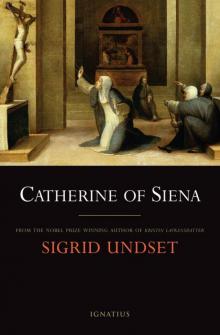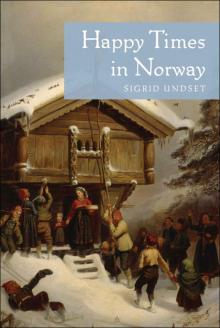- Home
- Sigrid Undset
Catherine of Siena
Catherine of Siena Read online
CATHERINE OF SIENA
SIGRID UNDSET
CATHERINE OF SIENA
Translated by Kate Austin-Lund
IGNATIUS PRESS SAN FRANCISCO
Original edition:
© 1951 by H. Aschehoug and Company (W. Nygaard) AS
Oslo, Norway
Original English edition
© 1954 by Sheed and Ward, Inc., New York
All rights reserved
Published with ecclesiastical approval
Cover art: Saint Catherine of Siena Receiving the Stigmata
Domenico Beccafumi (1486-1551)
Coll. Moss Stanley, Riverdale-on-Hudson, New York
© Scala / Art Resource, New York
Cover design by Roxanne Mei Lum
Published in 2009 by Ignatius Press, San Francisco
ISBN 978-1-58617-408-8
Library of Congress Control Number 2009923626
Printed in the United States of America
CONTENTS
Chapter I
Chapter II
Chapter III
Chapter IV
Chapter V
Chapter VI
Chapter VII
Chapter VIII
Chapter IX
Chapter X
Chapter XI
Chapter XII
Chapter XIII
Chapter XIV
Chapter XV
Chapter XVI
Chapter XVII
Chapter XVIII
Chapter XIX
Chapter XX
Chapter XXI
Chapter XXII
Chapter XXIII
Chapter XXIV
Chapter XXV
Chapter XXVI
Chapter XXVII
Chapter XXVIII
Chapter XXIX
I
IN THE CITY-STATES OF TUSCANY the citizens—Popolani—; businessmen, master craftsmen and the professional class had already in the Middle Ages demanded and won the right to take part in the government of the republic side by side with the nobles—the Gentiluomini. In Siena they had obtained a third of the seats in the High Council as early as the twelfth century. In spite of the fact that the different parties and rival groups within the parties were in constant and often violent disagreement, and in spite of the frequent wars with Florence, Siena’s neighbour and most powerful competitor, prosperity reigned within the city walls. The Sienese were rich and proud of their city, so they filled it with beautiful churches and public buildings. Masons, sculptors, painters and smiths who made the exquisite lattices and lamps, were seldom out of work. Life was like a brightly coloured tissue, where violence and vanity, greed and uninhibited desire for sensual pleasure, the longing for power, and ambition, were woven together in a multitude of patterns. But through the tissue ran silver threads of Christian charity, deep and genuine piety in the monasteries and among the good priests, among the brethren and sisters who had dedicated themselves to a life of helping their neighbours. The well-to-do and the common people had to the best of their ability provided for the sick, the poor and the lonely with unstinted generosity. In every class of the community there were good people who lived a quiet, modest and beautiful family life of purity and faith.
The family of Jacopo Benincasa was one of these. By trade he was a wool-dyer, and he worked with his elder sons and apprentices while his wife, Lapa di Puccio di Piagente, firmly and surely ruled the large household, although her life was an almost unbroken cycle of pregnancy and childbirth—and almost half her children died while they were still quite small. It is uncertain how many of them grew up, but the names of thirteen children who lived are to be found on an old family tree of the Benincasas. Considering how terribly high the rate of infant mortality was at that time, Jacopo and Lapa were lucky in being able to bring up more than half the children they had brought into the world.
Jacopo Benincasa was a man of solid means when in 1346 he was able to rent a house in the Via dei Tintori, close to the Fonte Branda, one of the beautiful covered fountains which assured the town of a plentiful supply of fresh water. The old home of the Benincasas, which is still much as it was at that time, is, according to our ideas, a small house for such a big family. But in the Middle Ages people were not fussy about the question of housing, least of all the citizens of the fortified towns where people huddled together as best they could within the protection of the walls. Building space was expensive, and the city must have its open markets, churches and public buildings, which at any rate theoretically belonged to the entire population. The houses were crowded together in narrow, crooked streets. According to the ideas of that time the new home of the Benincasas was large and impressive.
Lapa had already had twenty-two children when she gave birth to twins, two little girls, on Annunciation Day, March 25, 1347. They were christened Catherine and Giovanna. Madonna Lapa could only nurse one of the twins herself, so little Giovanna was handed over to a nurse, while Catherine fed at her mother’s breast. Never before had Monna Lapa been able to experience the joy of nursing her own children—a new pregnancy had always forced her to give her child over to another woman. But Catherine lived on her mother’s milk until she was old enough to be weaned. It was all too natural that Lapa, who was already advanced in years, came to love this child with a demanding and well-meaning mother-love which later, when the child grew up, made the relationship between the good-hearted, simple Lapa and her young eagle of a daughter one long series of heart-rending misunderstandings. Lapa loved her immeasurably and understood her not at all.
Catherine remained the youngest and the darling of the whole family, for little Giovanna died in infancy, and a new Giovanna, born a few years later, soon followed her sister and namesake into the grave. Her parents consoled themselves with the firm belief that these small, innocent children had flown from their cradles straight into Paradise—while Catherine, as Raimondo of Capua writes, using a slightly far-fetched pun on her name and the Latin word “catena” (a chain), had to work hard on earth before she could take a whole chain of saved souls with her to heaven.
When the Blessed Raimondo of Capua collected material for his biography of St. Catherine he got Madonna Lapa to tell him about the saint’s childhood—long, long ago, for Lapa was by that time a widow of eighty. From Raimondo’s description one gets the impression that Lapa enjoyed telling everything that came into her head to such an understanding and responsive listener. She told of the old days when she was the active, busy mother in the middle of a flock of her own children, her nieces and nephews, grandchildren, friends and neighbours, and Catherine was the adored baby of a couple who were already elderly. Lapa described her husband Jacopo as a man of unparalleled goodness, piety and uprightness. Raimondo writes that Lapa herself “had not a sign of the vices which one finds among people of our time”; she was an innocent and simple soul, and completely without the ability to invent stories which were not true. But because she had the well-being of so many people on her shoulders, she could not be so unworldly and patient as her husband; or perhaps Jacopo was really almost too good for this world, so that his wife had to be even more practical than she already was, and on occasion she thought it her duty to utter a word or two of common sense to protect the interests of the family. For Jacopo never said a hard or untimely word however upset or badly treated he might be, and if others in the house gave way to their bad temper or used bitter or unkind words he always tried to talk them round: “Now listen, for your own sake you must keep calm and not use such unseemly words.” Once one of his townsmen tried to force him into paying a large sum of money which Jacopo did not owe him, and the honest dyer was hounded and persecuted till he was almost ruined by the slanderous talk of this man and his powerful friends. But in spite of
everything Jacopo would not allow anyone to say a word against the man; Lapa did so, but her husband replied: “Leave him in peace, you will see that God will show him his fault and protect us.” And a short while after that it really happened, said Lapa.
Coarse words and dirty talk were unknown in the dyer’s home. His daughter Bonaventura, who was married to a young Sienese, Niccolo, was so much grieved when her husband and his friends engaged in loose talk and told doubtful jokes that she became physically ill and began to waste away. Her husband, who must really have been a well-meaning young man, was worried when he saw how thin and pale his bride was, and wanted to know what was wrong with her. Bonaventura replied seriously, “In my father’s house I was not used to listening to such words as I must hear here every day. You can be sure that if such indecent talk continues in our house you will live to see me waste to death.” Niccolo at once saw to it that all such bad habits which wounded his wife’s feelings were stopped, and openly expressed his admiration for her chaste and modest ways, and the piety of his parents-in-law.
Such was the home of little Catherine. Everyone petted and loved her, and when she was still quite tiny her family admired her “wisdom” when they listened to her innocent prattle. And as she was also very pretty Lapa could scarcely ever have her to herself; all the neighbours wanted to borrow her! Medieval writers seldom trouble to describe children or try to understand them. But Lapa manages in a few pages of Raimondo’s book to give us a picture of a little Italian girl, serious and yet happy, attractive and charming—and already beginning to show that overwhelming vitality and spiritual energy which many years later made Raimondo and her other “children” surrender to her influence, with the feeling that her words and her presence banished despondency and faint-heartedness, and filled their souls with the peace and love of God. As soon as she left the circle of her own family, little Catherine became the leader of all the other small children in the street. She taught them games which she had herself invented—that is to say innumerable small acts of devotion. When she was five years old she taught herself the Angelus, and she loved repeating it incessantly. As she went up or down the stairs at home she used to kneel on each step and say an Ave Maria. For the pious little daughter of a pious family, where everyone talked kindly and politely to everyone else, it must have been quite natural for her as soon as she had heard of God to talk in the same way to Him and His following of saints. It was then still a kind of game for Catherine. But small children put their whole souls and all their imagination into their games.
The neighbours called her Euphrosyne. This is the name of one of the Graces, and it seemed that Raimondo had his doubts about it; could the good people in the Fontebranda quarter have such knowledge of classical mythology that they knew what the name meant? He thought that perhaps, before she could talk properly, Catherine called herself something which the neighbours took to be Euphrosyne, for there is also a saint of that name. The Sienese were however used to seeing processions and listening to songs and verse, so they could easily have picked up more of the poets’ property than Raimondo imagined. Thus for example, Lapa’s father, Puccio di Piagente, wrote verse in his free time; he was by trade a craftsman—a mattress maker. He was moreover a very pious man, generous towards the monasteries and to monks and nuns. He might easily have known both the heathen and the Christian Euphrosyne. Catherine was for a time very much interested in the legend of St. Euphrosyne, who is supposed to have dressed as a boy and run away from home to enter a monastery. She toyed with the idea of doing the same herself. . . .
One evening, when Catherine was about six years old, she was on her way home after visiting her married sister Bonaventura. She was with two small boys, one of whom was her brother Stefano—he was a year or two older than she, and presumably was often commissioned by their mother to look after his little sister. The children had come to a place where the street goes steeply downhill between garden walls and house-fronts towards the valley, where Fontebranda’s charming stone canopy shades the well where the local women do their washing, or from which they pour the cold clear water into copper urns which they then carry home on their heads. On the other side of the valley are the great stone walls of the abbey church of San Domenico, massive and austere, with no other ornament than a series of windows with pointed arches built into the gable-end of the choir.
The little girl looked over the valley—it is called Valle Piatta. And then she looked up, over the roof of the church. She saw a sight so wonderful that she could never have dreamed of anything like it: the Saviour of the world sitting on a royal throne, clothed in a bishop’s robes, and with the triple crown of the Pope on His head. Beside Him stood the apostles St. Peter and St. Paul, and St. John the Evangelist. The child stood as though she were rooted to the spot. She stared enraptured at the vision “with the eyes both of her body and her soul”. Our Lord smiled lovingly at her, lifted His hand and blessed the child with the sign of the cross, as a bishop does. . . .
Catherine stood motionless, while the love of God streamed into her soul, illing her whole being and transforming it—for ever. Up and down the narrow street the evening bustle of people, ox-carts and riders passed, and at the top of the street stood the little girl, usually so shy, with her face and eyes upturned, as still as though she were made of stone.
The boys were already halfway down the hill when Stefano turned and looked for his sister, and saw her standing there, right at the top of the street. He called to her several times. Catherine did not move. He turned and ran up to her, calling her all the time—presumably somewhat impatiently. But she did not notice him until he took her arm, and asked her what she was doing. Then she looked as though she had woken from a deep sleep. She looked down and replied, “Oh, if you had seen what I see I am sure you would never have interrupted me and taken such a sweet sight from me.” When she looked up again the vision was gone. She began to weep bitterly, wishing that she had never turned from the heavenly vision.
When Raimondo of Capua had become her father confessor, Catherine told him that from that day she began to learn of the way the saints had lived, and especially of the life of St. Dominic and the Desert Fathers, though no one had taught her except the Holy Spirit. But a child of six can absorb a mass of knowledge without knowing where it comes from. The Dominican monastery with its fortress-like church lay at the top of the hill above her home. The preaching friars in the black and white robes of their order must have frequented the streets where the Benincasa children ran to visit their neighbours and married sisters. And in their house they had living with them a young boy who a few years later entered the Dominican Order—Tommaso della Fonte. He was the brother of Palmiero della Fonte who had married Niccoluccia Benincasa, and when Tommaso at the age of ten had lost his parents during the plague in 1349 he was given a home by his brother’s father-in-law. The fact that Catherine had a foster-brother who wished to be a Dominican living in the same house may have affected her more than she understood at the time, or could remember later.
But the moment when Catherine had seen heaven and received the blessing of her Saviour in a vision had changed her for ever. She was still a little child, but everyone at home noticed that she suddenly became so mature and so extraordinarily sensible that she was more like a grown-up than a little girl. She had been initiated. The perky little Euphrosyne had seen a glimpse of the overwhelming truth which she had been seeking when she played her pious games—she had stepped into the boundless worlds of God’s love and the love of God. Perhaps in a vague way she understood that her prayers and meditations had become a means by which she might prepare herself to receive a call—what it would be she did not know yet—which was to come one day from Him whom she had seen in a vision, and who had blessed her with His outstretched hand. However she had learned of the lives and practices of God’s saints, it is at any rate certain that Catherine now tried to imitate their vigilance and asceticism as well as she could. Quite unlike most growing children, she became qu
ieter and ate less than before. During the day her father and the men in the house worked in the dye-works in the cellar, and her mother and the women were occupied in the big kitchen which was also the household living-room—a large room at the top of the house, with a terrace in front where small shrubs and potted plants edged the parapet, and a line of washing fluttered in the wind. In the meantime the bedrooms on the floor between were empty most of the day. Catherine sought the solitude of one of these rooms and secretly beat her thin shoulders with a little whip. But naturally the other little girls of the neighbourhood discovered this fairly soon—children never respect a person’s need of being alone; and then they wanted to do what Catherine did, because they had got into the habit of imitating her. So they met in another out-of-the-way corner of the house and beat themselves, while Catherine said the “Our Father” and the “Hail Mary” as many times as she thought necessary. It was all delightfully secretive, and the little flock of small sisters of penitence must have felt highly edified and happy. It was also, as Raimondo remarks, a prologue to the future.
But sometimes Catherine longed to slip away from her playmates, especially the little boys. Then, her mother told Raimondo afterwards, she used to go up the stairs so quickly that Lapa was sure she did not touch the steps with her feet—it was as though she floated. This terrified her mother, for she was afraid the child would fall and hurt herself. The longing for solitude, and the legends of the Desert Fathers about which she thought so much, made Catherine dream of a cave in the desert where she could hide herself and discourse only with God.
One beautiful summer morning Catherine provided herself with a loaf of bread and went out alone in the direction of her married sister’s house near the Porta di San Ansano. But this time she went past it, and out of the gate, and for the first time in her life the little child of the city looked out over the quiet Valle Piatta and the green countryside. She was so used to her own world, with the houses close in on each other along the steep, narrow streets, and the swarms of people on foot or horseback, the donkeys, the ox-carts and the teams of mules, the dogs, and—ever-present members of all Italian families—the cats, that Catherine almost certainly thought that this green and peaceful world must be the desert. So she walked on and looked for a cave. Along the sides of the valley there were many grottoes in the limestone hills, and as soon as she had found one which she thought would be suitable she went in and knelt down. She began to pray as devoutly as she could. But in a little while an extraordinary feeling came over her—it was as though she were lifted up from the floor of the cave and floating under the roof. She was afraid that this was perhaps a temptation of the devil—that he was trying to frighten her out of praying. So she continued to pray even more devoutly and determinedly. When she awoke from her trance and found herself on her knees on the floor of the cave it was the time of Nones—three o’clock in the afternoon, the hour when the Son of God died on the cross.

 In the Wilderness
In the Wilderness The Bridal Wreath
The Bridal Wreath Catherine of Siena
Catherine of Siena Marta Oulie: A Novel of Betrayal
Marta Oulie: A Novel of Betrayal The Snake Pit
The Snake Pit The Axe
The Axe Happy Times in Norway
Happy Times in Norway The Son Avenger
The Son Avenger Kristin Lavransdatter
Kristin Lavransdatter